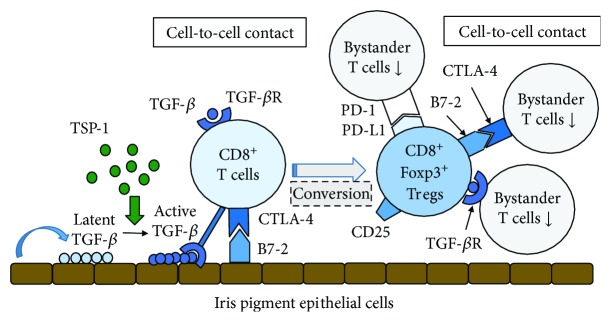Figure 1.
Molecular mechanism underlying the generation of regulatory T cells (Tregs) by murine iris pigment epithelial (PE) cells. Cultured iris PE cells suppress anti-CD3-driven T cell activation in vitro by direct cell contact in which B7-2 (CD86) expressed by iris PE cells interacts with cytotoxic T-lymphocyte antigen-4 (CTLA-4) on responding T cells. Furthermore, cultured iris PE cells expressing B7-2 induce the activation of CTLA-4+CD8+ T cells that express their own B7-2 and secrete enhanced amounts of active transforming growth factor beta (TGF-β), leading to the global suppression of entire T-cell populations including CD4+ T cells. Both iris PE cells and T cells exposed to iris PE cells upregulate their TGF-β and TGF-β receptor (TGF-βR) genes and suppress bystander T cells using membrane-bound or soluble TGF-β. In addition, iris PE cell-induced Foxp3+CD8+CD25+ Tregs suppress bystander T cells through cell contact via B7-2/CTLA-4 and/or programmed cell death- (PD-) 1/PD-L1 interactions. Thrombospondin-1 (TSP-1) produced from iris PE cells greatly contributes to the conversion of TGF-β from latent form to active form.

